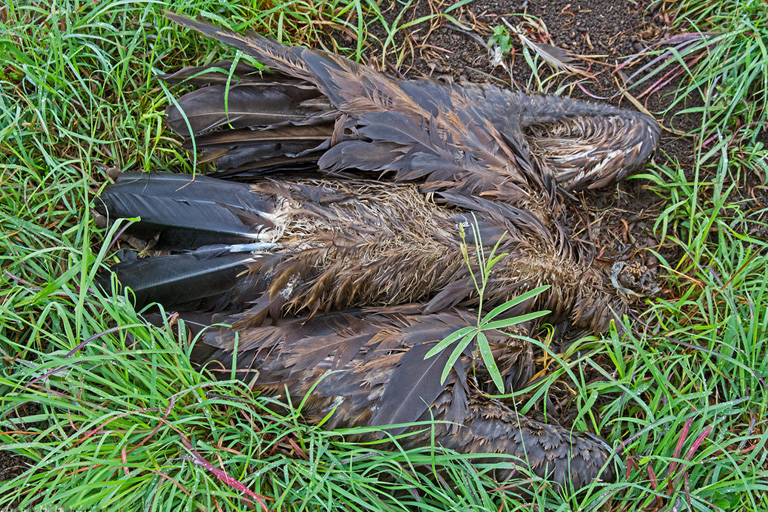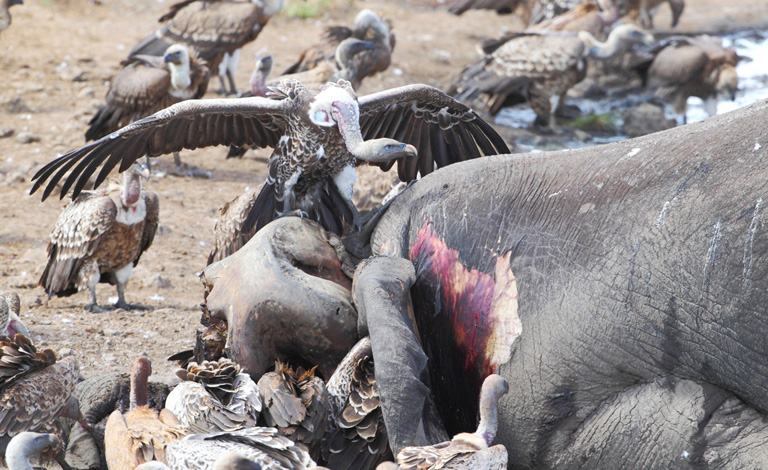- A study shows that the trade of vulture bodies and parts is the main factor in the birds’ approaching extinction in Africa.
- Many Africans use the birds’ bodies because they believe certain body parts bestow clairvoyant abilities.
- Poachers use powerful pesticides to poison large animals, killing vultures that feed on the tainted carcasses.
Ask anyone dangling a rabbit’s foot from their keychain what the severed appendage is for, and they’ll tell you it brings good fortune. Ask a traditional healer in West or Central Africa how to boost your luck, and they may offer a different prescription: to smoke or snort dried vulture brains.
Rabbits survived the trend, but African vultures are not faring as well. A recent study, published in the journal Oryx, suggests the trade of vulture carcasses and their body parts in West and Central Africa, driven largely by superstition, is pushing the birds toward extinction.
“This is not a single species decline. It’s an unprecedented decline of an entire functional group,” said lead author Ralph Buij at the Wageningen University and Research Centre in the Netherlands.

Buij and his coauthors counted 2,646 carcasses from hundreds of market stands throughout West and Central Africa over 23 years. More than one-quarter of the bodies belonged to species the IUCN considers Endangered, Vulnerable, or Near-threatened. Poachers targeted common scavenging birds more often than rare or non-scavenging ones.
Because vultures appear mere moments after creatures die, many Africans believe the birds are clairvoyant. People can assume those abilities by ingesting a bird’s brain, eyes, or tongue, according to widespread tradition. Others believe sprinkling minced body parts around the house or burying vulture heads beneath doorways drives away evil spirits, Buij told Mongabay.


The superstitions crop up in many social circles, from men gambling on racehorses to schoolchildren trying to predict exam questions. Because of the tales’ ubiquity and the fact that a single carcass can deliver several months’ salary, poachers have a strong incentive to wipe vultures from the landscape. But their absence spells disaster, said coauthor Darcy Ogada, assistant director of Africa Programs at the Peregrine Fund in Kenya.
“These animals are extremely important to our ecosystems,” Ogada told Mongabay. “They’re almost entirely beneficial to mankind.” Vultures are nature’s cleanup crew. When a flock descends upon a carcass, the birds can clean it to the bone in as few as 20 minutes. Their powerfully acidic stomachs eradicate harmful bacteria thriving in rotting tissue.

“There are no other animals that can take their place,” said Andre Botha, co-chair of the IUCN Species Survival Commission Vulture Specialist Group, who didn’t participate in the study. “And when they’re gone, they’re gone.”
Indeed, a study published earlier this year in the journal Conservation Letters, coauthored by Bocha, Ogada, and Buij, showed that vultures are closer than ever to vanishing. The scientists took the first continent-wide estimate of African vulture populations. They found that several species now qualify as critically endangered after declining 80 percent or more over the past three decades.
Though poachers kill vultures with guns and other devices, the weapon they favor most is poison. Powerful pesticides planted in a carcass can set off a deadly chain reaction, and the vultures drop dead after feeding. When researchers stumble upon a circle of headless vultures, Ogada said, the missing heads are a telltale sign that the poisoning was trade-related.

In some countries, poachers face prison sentences for hunting vultures. But in Nigeria and Benin, where the use of vulture parts for traditional medicine is common, marketers trade openly. Not all acquiesce to the trade, however. Some villagers, Botha said, chase poachers away from their homes, fearing that the hunters will poison water sources visited by not only wildlife, but also livestock and even children.
“It’s almost unthinkable that Africa’s skies could one day not have vultures in them,” Botha said. “Based on what we’re seeing now, that scenario seems to be a very real one, and we just can’t afford that.”

Citations:
Buij, R., Nikolaus, G., Whytock, R., Ingram, D. J., & Ogada, D. (2015). Trade of threatened vultures and other raptors for fetish and bushmeat in West and Central Africa. Oryx, 1-11. DOI: 10.1017/S0030605315000514
Ogada, D., Shaw, P., Beyers, R. L., Buij, R., Murn, C., Thiollay, J. M., … & Sinclair, A. R. (2015). Another Continental Vulture Crisis: Africa’s Vultures Collapsing toward Extinction. Conservation letters. DOI: 10.1111/conl.12182
Brendan Bane is a graduate student in the Science Communication Program at the University of California, Santa Cruz. Other Mongabay stories produced by UCSC students can be found here